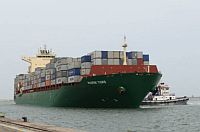 Yesterday, we posted about the Maersk Tigris, a 5470-TEU container ship, which was detained by boats from the Iranian Revolutionary Guard. Here is what we know so far.
Yesterday, we posted about the Maersk Tigris, a 5470-TEU container ship, which was detained by boats from the Iranian Revolutionary Guard. Here is what we know so far.
1. Is the Maersk Tigris a “U.S. cargo ship?”
No. Initially, Saudi owned Al-Arabiya and several Iranian new sources reported that the ship was a “U.S. cargo ship.” Nevertheless, the Maersk Tigris is owned by a Danish shipping company, is registered in the Marshal Islands and has no US citizens aboard. Oddly, boats from the Iranian Revolutionary Guard did intercept a US flag container ship, Maersk Kensington, last Friday, but did not detain the ship.
2. Was the ship seized in international waters or Iranian territorial waters?
Yes. Both. Sort of. The Strait of Hormuz is a major international thoroughfare. About 20% of the world’s petroleum, and about 35% of the petroleum traded by sea, passes through the strait. The problem is that the Strait of Hormuz is only 21 miles wide. Both Iran and Oman, across the strait, claim a 12 mile limit to their territorial waters. Ships travelling through the strait pass through the territorial waters of Iran and Oman. Under the transit passage provisions of the United Nations Convention on the Law of the Sea, all ships have the right of “innocent passage” through the strait. The United States has not ratified the Law of the Sea convention, but accepts the customary navigation rules as codified by it.
3. Why was the Maersk Tigris detained?
Iran’s semi-official news agency FARS is reporting that the ship was seized at the request of Iran’s Ports and Maritime Organization after a relevant court order was issued, indicating that the IPMO had monetary differences with the ship owner. The ship manager, Rickmers, which operates the ship on behalf of Maersk, has been largely silent. They have issued a statement on the seizure of the ship, which does not comment on the claim beyond saying that: “The company would like to emphasize that it takes its responsibilities as an international shipping line very seriously complying with all applicable laws and regulations and ensuring that employees are aware of those laws relevant to their roles.”
4. Where is the ship now? How is the crew?
The latest reports show the ship at anchor in the strait. Maersk Line says the crew is fine. “We are in on-going contact with Rickmers Shipmanagement and are pleased to learn that the crew is safe and under the circumstances in good spirits. The well-being of the crew remains our paramount concern.”
5. The ship is flying the Marshall Island flag. What does that mean?
In most cases, it doesn’t mean too much. The Marshall Island flag is an open registry, often termed a “flag of convenience.” Critics of the “flags of convenience” argue that ship owners flag their ships under these flags to save money and avoid regulation. On the other hand, the Republic of the Marshall Islands, an island nation in the middle of the Pacific, while technically a sovereign country, is bound to the United States through a Compact of Free Association. This compact includes a US agreement to provide military support.
6. None of this really makes sense. Is something else going on?
Possibly. Last week, a US aircraft carrier group moved into position to block a nine-ship Iranian naval convoy suspected of carrying weapons bound for Shiite rebels. The convoy turned away, apparently to avoid a confrontation with the American Navy. A day later Revolutionary Guard boats stopped the Maersk Kensington in the strait and yesterday the Maersk Tigris was detained. Are the events related? That is very hard to say.

Pingback: Iran takes ship
My good friend that I’ve known since high school sent this to me on Tue, Apr 28, 2015, 12:06 PM
“34 US sailors onboard”, bla, bla, bla.
http://english.alarabiya.net/en/News/middle-east/2015/04/28/Iran-holds-U-S-ship-34-sailors-.html
My hunch is that hardliners in the Revolutionary Guard grabbed the ship, hoping to provoke an incident that would scuttle the nuclear treaty currently being negotiated with Iran.
I suspect that the relatively moderate president of Iran, who supports the treaty, will ask the Supreme Leader to call off the Revolutionary Guards. If the Supreme Leader wants the treaty, he will, if not, he won’t.